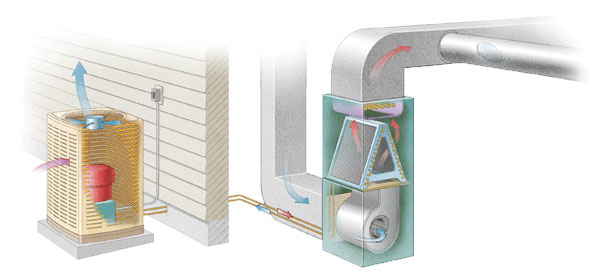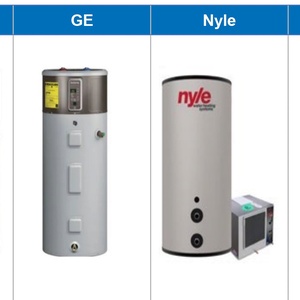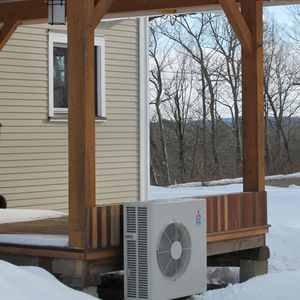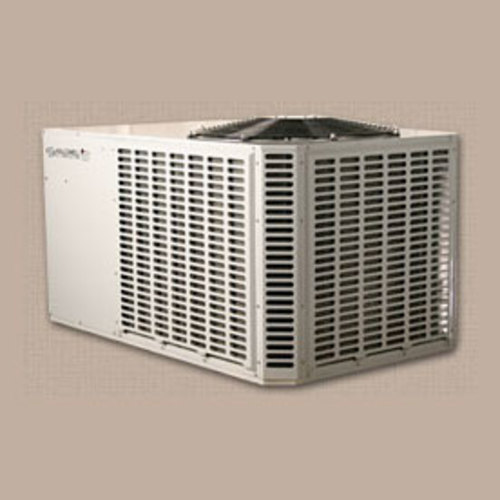
Image Credit: John Hartman / Fine Homebuilding
I used to think that electric heating should be avoided at all cost. After all, most of our electricity is produced from highly polluting and greenhouse-gas- spewing coal power plants or from nuclear power plants with their own, quite different, risks. I bought in to physicist Amory Lovin’s argument that heating buildings with electricity was like “cutting butter with a chainsaw.” It just didn’t make sense, Amory said, to use such a high-grade and versatile form of energy to provide something as crude as heat.
I’ve changed my tune on this, however. For an extremely well-insulated (superinsulated) new house—the only kind of house we should be building today—supplying the very small amount of needed heat using electricity can make a lot of sense. In fact, doing so may enable us to create a net-zero-energy house if we generate our own electricity using photovoltaic (solar-electric) panels or a wind turbine.
The easiest way to turn kilowatt-hours (kWh) of electricity into British thermal units (Btus) of heat is to use “electric resistance heat” in baseboard radiators. An electric-resistance heating element is 100% efficient at converting the electricity supplied to it into useful heat. (Note that if we consider the fuel used by the utility company to generate that electricity—referred to as the “source energy”—that electricity is far less efficient, because only about a third of the energy content of coal or uranium is actually converted into electricity.)
Converting electricity into heat at 100% efficiency may sound pretty good, but we can actually do even better. With a heat pump, we can get more than twice as much heat from each kWh of electricity than we can with electric-resistance heat. We can also use the same heat pump for air conditioning.
So what is a heat pump, and how can it be more than 100% efficient? Instead of converting electricity directly into heat, heat pumps use electricity to move heat from one place to another. Hang onto your cup of coffee; explaining how this works is a little confusing. It’s based on a principle from your old high school chemistry class: that when something changes state (solid, liquid, or gas), it gives off or absorbs heat, sometimes counter-intuitively.
The thing that’s hard to grasp is that the heat pump can extract heat from a cooler place (the outdoors or underground) and deliver it to a warmer place—your house. It does this by alternately compressing and evaporating a special fluid—called a refrigerant—in a closed loop. Refrigerants are special fluids that can be changed from liquid to gas, and vice-versa, by changing the pressure.
When a refrigerant evaporates (changes from liquid to gas) it absorbs heat. During the winter, this is how a heat pump extracts heat from the outside air or the earth. We can extract heat even if that “heat source” is at a very low temperature. When the refrigerant condenses (changes from gas to liquid) it releases heat that can be delivered to the house. The heat pump uses electricity to compress the gaseous refrigerant into a liquid and then an expansion valve to evaporate the liquid back into a gas.
A great feature of heat pumps is the ability to switch from heating mode (just described) to a cooling mode that works the same way with the process reversed—so that it cools, rather than heats, your house. In the cooling mode, a heat pump extracts heat from your house and dumps it outdoors—with the outside air (or the ground) becoming the “heat sink.”
What I’ve described here is the “refrigeration cycle”—and it’s how most air conditioners, heat pumps, refrigerators, and dehumidifiers work. Inventor Willis Carrier first used this for air conditioning just over a century ago, and the company he founded, Carrier Corporation, remains one of the world’s largest manufacturers of heat pumps and air conditioners.
The refrigerant in a heat pump or air conditioner is often referred to by the Dupont trade name, Freon. There are different types of refrigerants, many of which have been found to damage the earth’s protective ozone layer so have been banned or are in the process of being phased out. Eliminating these ozone-depleting compounds is important because, even though a properly functioning heat pump or air conditioner is a closed loop that keeps the refrigerant contained, leaks sometimes occur and the refrigerant can be lost into the atmosphere. When equipment with ozone-depleting refrigerants is disposed of, the refrigerant must be recovered for proper disposal.
There are two types of heat pumps. “Air-source” heat pumps use the outside air as the heat source in the winter and the heat sink in the summer. “Ground-source” heat pump, sometimes called “geothermal” heat pumps, use the ground as the heat source and heat sink. Because ground temperatures are much more uniform year-round than air temperatures (warmer in the winter and cooler in the summer), ground-source heat pumps are inherently more energy efficient.
In upcoming columns I’ll discuss different types of heat pumps in a little more detail.
Weekly Newsletter
Get building science and energy efficiency advice, plus special offers, in your inbox.















0 Comments
Log in or create an account to post a comment.
Sign up Log in